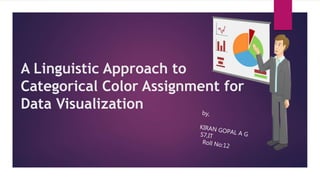
A linguistic approach to categorical color assignment
- 1. A Linguistic Approach to Categorical Color Assignment for Data Visualization
- 2. Contents: INTRODUCTION COLOR NAME AND COGNITION COLOR AND LANGUAGE MAPPING NAME TO COLORS PALETTE GENERATION DISCUSSION AND FUTURE WORK CONCLUSION REFERENCE A LinguisticApproach to Categorical Color Assignment for DataVisualization
- 3. Introduction Here for the data visualization the coloring is done by a well-designed default categorical palette, with colors that are optimized for legibility and mapped to basic color names. There is no semantic relationship between the colors used in the visualization and those commonly associated with these data. The goal of this research is to aid in the semantic mapping of coloring to data, both by presenting a specific technique and by discussing the challenges and trade-offs discovered in this work. A LinguisticApproach to Categorical Color Assignment for DataVisualization
- 4. Color names and cognition Focuses on basic color names, studying how these names are represented in different languages and cultures. For English (and many similar European languages), there are 11 basic color names: red, green, blue, yellow, orange, purple, pink, brown, black, white and gray. Furthermore, there is strong agreement on the color stimuli, in this case, defined by a set of Munsell color chips that are exemplars of these names. A LinguisticApproach to Categorical Color Assignment for DataVisualization
- 5. There is a fundamental link between language and color cognition is demonstrated by the Stroop effect. When the color of the letters is in conflict with the color described by the word (for example, the word ‘blue’ is written in red letters), subjects find it harder to name the color of the letters. A LinguisticApproach to Categorical Color Assignment for DataVisualization
- 6. Color and Language This suggests that linguistic data sources that consider the semantics of color names might provide for better reference, selection and retrieval of colors for various tasks, including for categorical palettes in data visualizations use n-gram analysis to determine the relationship between terms and basic colors, they use the links provided in ConceptNet. They do not use images to determine colors, but depend instead on finding color centroids semantically. In addition, their focus is on returning one ideal color, not a set of color options. A LinguisticApproach to Categorical Color Assignment for DataVisualization
- 7. Mapping Names to Colors A common way to map names to colors is to fit statistical models to human judgments of color- name associations. Typical color naming data .However, is created by asking people to describe a displayed color in language. The data for these models is created by showing people color patches and asked to name them, sometimes freely, and sometimes with a constrained vocabulary. Categorical data typically does not directly describe colors, but are rather concepts with a strong color association. Therefore, we need a way to map an arbitrary word or phrase to a color. A LinguisticApproach to Categorical Color Assignment for DataVisualization
- 8. Search Parameters For any word or phrase, the Google n-gram analysis provides a colorability score and a list of basic colors that are strongly associated with that phrase. This information is used to determine if a given term is colorable, and if so, the list of basic colors is used as a query parameter to obtain images with those dominant colors. A LinguisticApproach to Categorical Color Assignment for DataVisualization
- 9. Query Expansion and Image Retrieval The basic color names can be used as input queries to an image search engine, the query words may be different than the ones used in the metadata describing the semantics of the imagery. We use query expansion to augment related terms to each of the queries for improving search precision and recall. Once the query is executed, the result set of images returned are accompanied by a normalized confidence measure from the Google search engine A LinguisticApproach to Categorical Color Assignment for DataVisualization
- 10. A LinguisticApproach to Categorical Color Assignment for DataVisualization Canonical colors retrieved from Google Images using dominant filtering for ‘taxi’, ‘lizard’ and ‘saffron.’
- 11. PALETTE GENERATION Effective categorical color palettes encode visually distinct colors to different categorical values for distinction, in addition to the color being as semantically meaningful to the corresponding value. A LinguisticApproach to Categorical Color Assignment for DataVisualization Color Palette
- 12. Color Palettes A LinguisticApproach to Categorical Color Assignment for DataVisualization Color Chart
- 13. Color Hex Codes A LinguisticApproach to Categorical Color Assignment for DataVisualization Color Hex Codes
- 14. Color Hex Values A LinguisticApproach to Categorical Color Assignment for DataVisualization Color Hex Codes
- 15. Future Work For a set of data categories, our techniques can provide two useful pieces of information – Whether the terms have strong associations to color. Second, if there are such color associations, what are the corresponding semantic colors. In addition, we can construct palettes that contain distinctly different colors, either as defined in CIELAB space or by mapping to a pre-defined palette. In some cases, the results are adequate as returned. In others, there needs to be additional refinement. A LinguisticApproach to Categorical Color Assignment for DataVisualization
- 16. data visualization tools Tableau D3.js Fusion Charts Chart.js Google Charts Data wrapper Power BI A LinguisticApproach to Categorical Color Assignment for DataVisualization
- 17. CONCLUSION Two ways to leverage natural language techniques to map category names to semantically appropriate colors. The first uses n-gram analysis with respect to basic color names. The second semantic context for the data category, to find identity colors from visual symbols such as logos. Both return scores that can be used to determine if a data term has a semantic coloring A LinguisticApproach to Categorical Color Assignment for DataVisualization